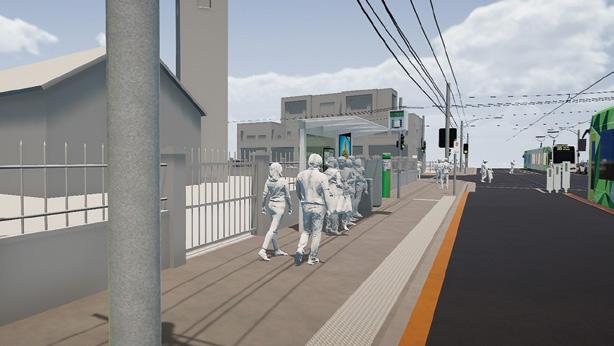
4 minute read
Development Victoria
UPGRADING THE WORLD’S LARGEST TRAM NETWORK
The Victoria Department of Transport, together with the Victorian network operators and service providers are striving towards a more accessible and inclusive public transport network for all.
Advertisement
Home to the world’s largest tram network, Melbourne is upgrading 75 per cent of its stops to meet the future Disability Standards for Accessible Public Transport legislation. The government required tram user input to form a strategy on how to design and implement tram stop upgrades in alignment with the legislation.
The Department of Transport engaged Aurecon to assist them to build on, and refine, insights generated from earlier user research, and develop more specific user requirements for tram stops, to ensure they improve accessibility and customer experience.
Key features of an accessible, modern, secure, and integrated tram network:
⋅Stops that are accessible to people with a disability, limited mobility and parents with prams ⋅ Modern facilities that meet the needs of a growing population ⋅ Integration with the urban realm to allow seamless transfers between all transport modes for all customers
User-centred design creates an integrated process
Aurecon’s user-centred design approach was employed to determine how people interact with the tram stops and the pain points they face.
Our research sought to uncover the whole user travel experience, taking a passenger’s view. We collaborated with social enterprise Ability Works to develop an understanding of the experiences of different users and non-users, their needs, and pain points, experienced at key tram stop types. Ability Works’ employees and community provided insights into the public transport journey faced by people with accessibility challenges.
One in five people within the Australian population live with a disability said Ability Works Chief Executive Officer, Sue Boyce. “Our employees and community were so excited to be able to contribute to a major infrastructure project. It was mindblowing for them – they couldn’t believe that they were being asked for their opinion.” Sue Boyce, Ability Works Chief Executive Officer
LOCATION: Wurundjeri Country, Melbourne, Victoria, Australia CLIENT: Department of Transport PARTNERS: Ability Works AURECON’S ROLE: Digital engineering tools to develop a series of digital twin tram stop designs using visualisation and Unsigned Studio EXPERTISE: Digital engineering & advisory, Integrated design Melbourne is upgrading the world’s largest tram network stops to meet the future Disability Standards for Accessible Public Transport legislation.
Aurecon was able to understand the articulated, as well as the unarticulated, customer needs and pain points. The data was distilled into six central themes: connectivity, confidence, comfort, choice, convenience, and safety.
Engaging in challenging times
The ability to conduct in-field observational research was curtailed due to COVID-19. Aurecon used digital engineering tools to develop a series of digital twin tram stop designs using visualisation.
This was developed through our inhouse agency – Unsigned Studio and Aurecon Digital Tool siteLab® to bring the designs to life.
The visualisations simulated the tram stop experience, coupled with immersion techniques, to help users to better replicate their typical user mindset. Seven types of virtual tram stops were modelled, based on a shortlist of stops developed by the Department of Transport.
The team engaged with some of Melbourne’s most vulnerable tram users, all living with a disability. This was in addition to tram users without accessibility impediments, cyclists, pedestrians, and car drivers.
Participants were immersed in their transport user mindset and the digital models using hypothetical scenarios and
strong storytelling to ground the research participant in the scenario and place them as the lead character in their story.
The visualisations allowed research participants to ‘walk’ around the virtual world as if they were at the tram stop. The digital twin also allowed for the line of sight of a wheelchair user. The process brought empathy and understanding to see things from another perspective.
Community research was undertaken remotely with people accessing the visualisation from the safety and comfort of their home and providing feedback via interviews using webbased collaboration tools.
A range of testing scenarios such as weather (sun, rain, cloudy days), time of day (off-peak and peak – including greater numbers of pedestrians and vehicles) were tested with participants in a way that would have been unlikely during in-field observations.
“Aurecon’s willingness and the adaptability of the team, especially with the visualisations, has been standout.” Jacquelyn Viti, Senior Transport Planner and Project Lead with The Department of Transport
A digital twin for design
The other benefit of the visualisation is that the Department of Transport now has a digital twin of each of the seven standard tram stop designs. These digital twins replicate real life physical infrastructure at scale and present it in a digital environment. This is beneficial to the Department of Transport in undertaking real-time scenario assessments for transport planning.
The additional benefit of the digital twins is that they can be quickly and easily changed to prototype new tram stop designs with in-situ features, to test new tram stop concepts with future research participants.
Assessing seven unique tram stop types, with a broad range of users and non-users, provided a deeper understanding of which aspects of the tram stop design, location and broader context were successful or not, and which elements will service them better in future.
The benefits of inclusive design
By taking an integrated approach and translating user insights into the movement and place framework, the power of the user’s voice will be maintained during the next phases of the project – development of the user requirement guidelines and then the design for future tram stops throughout the network.
Trams and tram stops are an intrinsic part of the inner and middle suburbs of Melbourne. The way that the user’s voice has been integrated with digital visualisation on this project will help make the tram network more resilient, accessible, and usable.










